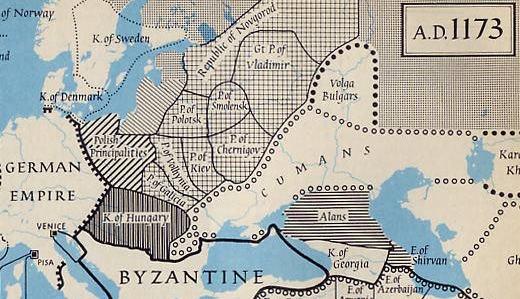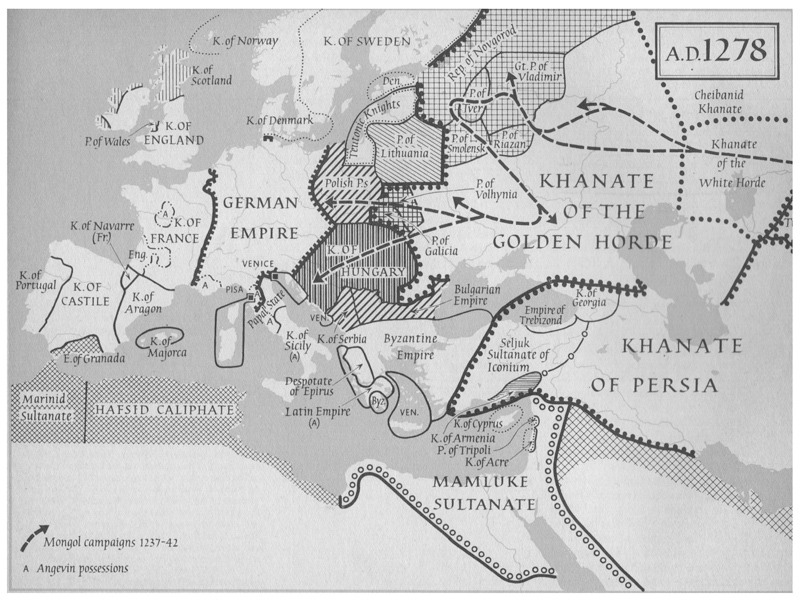Please note that I follow no consistent system of transliterating Russian or Ukrainian names into the Latin alphabet. Names in anything I write in this area should be understood as hopefully recognisable symbols of the persons and places etc they represent.
A FRONTIER BETWEEN CIVILISATIONS
The word 'Ukraine', as I'm sure everyone knows by now, means 'frontier' or border country. The border in question was the country that separates Poland, Russia and the Crimean Tatars. The Poles were Catholic, the Russians Orthodox. The Tatars were the descendants of the religiously eclectic Mongol 'Golden Horde', which had swept through the whole area in the thirteenth century but had since allied with the Ottoman Empire and therefore represent Islam.
This map shows the frontier as it was in the late seventeenth century. Had I shown a map from earlier in the seventeenth century, the line would have been further to the East. 'Poland' would have been bigger. But I chose this map because it shows the wider area - the relationship to Constantinople in the South and to the Baltic region in the North. The line of the frontier shown here coincides roughly with the 'Varangian route' - the trade route that ran from the Baltic, the Scandinavian countries, in the North to the Black Sea in the South, which explains the importance of the city of Kiev, which also lay on the trade route from East to West, from Asia to Europe.
Both Ukrainians and Russians claim descent from the tenth century Kingdom of Rus, centred on Kiev. The Kingdom lasted as a cultural unity for some three hundred years but had a tendency to break up into smaller, more or less allied principalities.

In this map one could see in Novgorod and Vladimir Suzdal in the North the seedbed of what was to become Russia and, in the West, in Galicia/Volhynia, the seedbed of what was to become modern Ukraine. Note that the actual coastal area of both the Black and Azov seas were out of control of the Kievans as they would continue to be out of control of Poles, Lithuanians and Russians until the late eighteenth century.
Kiev had adopted Orthodoxy from Constantinople in 988. Poland in the West had adopted Catholicism from Rome in 966. Although the formal date given for the Great Schism between Rome and Constantinople, Catholicism and Orthodoxy, is 1054, the difference between them was already deeply felt.
Kievan Rus was submerged in the great wave of the invasion by the Golden Horde in the thirteenth century.

Kiev was sacked and its population massacred in 1240. As a result the Metropolitan of Kiev transferred, first (1299) to Vladimir, then (1326) to Moscow while still retaining 'Kiev' in his title. In the same year (1240) as the sack of Kiev, a young prince in Novgorod, Alexander, won the battle of the Neva against the Swedes, thus earning the name Alexander Nevski. This, together with the subsequent victory over the Teutonic Knights in 1242, was a civilisational choice. Alexander had accepted submission to the Tatars in preference to incorporation into the Catholic West. A similar choice was made by the Galician-Volhynian Prince, Daniel Romanovich, on the advice of the then Metropolitan of Kiev and against the appeals of the Pope. He was the founder of the town of Lviv. But in 1340, about the time of the Battle of Kulikovo when the Muscovites broke free of the Tatar yoke, Galicia-Volhynia made an opposite choice. The last prince of Galicia-Volhynia, Yurii II Boleslav, was murdered, poisoned by his boyars. Galicia fell into disarray and was fought over by different Galician factions, Hungary and Poland until, through an agreement between Poland, Hungary and Lithuania, it was incorporated into Poland in 1387. After struggles with Poland, Lithuania gained control of Volhynia in 1370.
The Ukrainians could be described as those Orthodox descendants of Kievan Rus who came under Polish/Lithuanian domination, partly at least to protect themselves against the Tatars, still powerful in most of the area covered by modern Ukraine.
This map shows the area as it was in 1453. In the following, sixteenth, century, Novgorod and most of the territory covered by the khanates would come under Muscovy, led by the Grand Duke Ivan III and his son, the first 'Tsar', Ivan IV (the 'Terrible'). (1)
(1) The early part of this account is drawn from a variety of sources including different articles in the Encyclopedia of Ukraine (available online), Dmitri Pospielovsky's The Orthodox Church in the history of Russia and Ludmilla Liyaeva: The Ukrainian Icon, 11th-18th centuries.